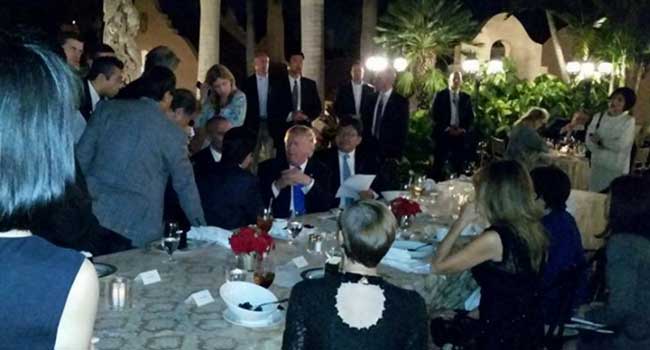
Patio Situation Room Raises Security Questions
Over the weekend, North Korea launched an intermediate-range ballistic missile, its first challenge to international rules since Donald Trump was sworn in almost a month ago.
The launch was obviously unexpected as the breaking news came to the president as he sit down to dinner at the Mar-a-Lago with Japanese Prime Minister Shinzo Abe and several other people.
Trump sat next to Abe as he took the call on a mobile phone at his less-than-private table in the middle of the Mar-a-Lago dining room.
Several diners in President Trump’s vicinity at the time of the breaking news were not national security or government members, but just happened to be dining on the same patio Saturday evening as the President.
Many worried that those in the area were able to see and hear classified information as the President and his national security advisers huddled around the table to discuss policy.
The episode was captured by a diner and posted to a Facebook page. In the post, Richard DeAgazio said, “HOLY MOLY! It was fascinating to watch the flurry of activity at dinner when the news came that North Korea had launched a missile in the direction of Japan. The Prime Minister Abe of Japan huddles with his staff and the president is on the phone with Washington DC. The two world leaders then conferred and then went into another room for [sic] hastily arranged press conference. Wow… the center of the action!”
House Minority Leader Nancy Pelosi tweeted, “There’s no excuse for letting an international crisis play out in front of a bunch of country club members like dinner theater.”
Presidents usually travel with secure communications equipment, even when they are on vacation. A Sensitive Compartmented Information Facility, known as a SCIFF, also comes along. The tent-like structure can fit inside a hotel room and allows a president to conduct sensitive phone calls without the risk of being detected by recording devices.
Former President Barack Obama’s staff photographer, Pete Souza, uploaded a photo to his Instagram to show how Obama handled conversations laced with sensitive material while he was traveling.
“When we were on the road, national security discussions and head of state phone calls were conducted in a private, secure location set up onsite,” Souza said in the caption of the photo. “Everyone had to leave their Blackberry outside the area. In this photo, which was taken in March 2011 and subsequently released, the President holds a discussion in El Salvador following a conference call with his full national security team.”
On Monday, White House Press Secretary, Sean Spicer, told reporters that President Trump had utilized the security measures brought with him to ensure secure communication.
"The President was briefed in a SCIFF prior to dinner," Spicer said. "They were reviewing the logistics for the press conference ... President was subsequently briefed in a classified setting.”